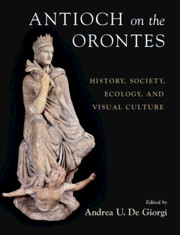Book contents
- Antioch on the Orontes
- Antioch on the Orontes
- Copyright page
- Dedication
- Contents
- Plates
- Figures
- Tables
- Contributors
- Abbreviations
- Antioch on the Orontes
- Part I Beginnings
- Part II The Making of a Capital
- Part III The People of Antioch
- Part IV Religion
- Chapter 22 The First Christians of Antioch
- Chapter 23 Christian Antioch
- Chapter 24 Julian in Antioch
- Chapter 25 The Churches of Antioch in the Life of the City
- Chapter 26 Who Is Jesus Christ?
- Part V Crises and Resilience
- Index
- Plate Section
- References
Chapter 24 - Julian in Antioch
from Part IV - Religion
Published online by Cambridge University Press: aN Invalid Date NaN
- Antioch on the Orontes
- Antioch on the Orontes
- Copyright page
- Dedication
- Contents
- Plates
- Figures
- Tables
- Contributors
- Abbreviations
- Antioch on the Orontes
- Part I Beginnings
- Part II The Making of a Capital
- Part III The People of Antioch
- Part IV Religion
- Chapter 22 The First Christians of Antioch
- Chapter 23 Christian Antioch
- Chapter 24 Julian in Antioch
- Chapter 25 The Churches of Antioch in the Life of the City
- Chapter 26 Who Is Jesus Christ?
- Part V Crises and Resilience
- Index
- Plate Section
- References
Summary
The Emperor Julian’s momentous sojourn in Antioch is a key theme in the discourse of Christianity and paganism in the Greek East. This chapter chronicles the events and climate of 362 and 363 CE on the shores of the Orontes, not least highlighting Julian’s utopia of Antioch "city of marble."
- Type
- Chapter
- Information
- Antioch on the OrontesHistory, Society, Ecology, and Visual Culture, pp. 391 - 405Publisher: Cambridge University PressPrint publication year: 2024



